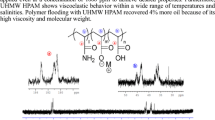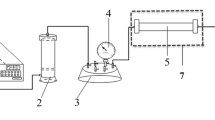Abstract
Polymer flooding represents one of the most efficient processes to enhance oil recovery, but the poor thermostability and salt tolerance of the currently used water-soluble polymers impeded their use in high temperature and salinity oil reservoirs. Thermoviscosifying polymers (TVPs) whose viscosity increases upon increasing temperature and salinity may overcome the deficiencies of most water-soluble polymers. A novel TVP was studied in comparison with traditional partially hydrolyzed polyacrylamide (HPAM) in synthetic brine regarding their rheological behaviors and core flooding experiments under simulated high temperature and salinity oil reservoir conditions (T: 85 °C, and total salinity: 32,868 mg/L, [Ca2+] + [Mg2+]: 873 mg/L). It was found that with increasing temperature, both apparent viscosity and elastic modulus of the TVP polymer solution increase, while those of the HPAM solutions decrease. Such a difference is attributed to their microstructures formed in aqueous solution, which were observed by cryogenic transmission electron microscopy. Core flow tests at equal conditions showed an oil recovery factor of 13.5 % for the TVP solution versus only 2.1 % for the HPAM solution.






Similar content being viewed by others
References
Thomas S (2008) Enhanced oil recovery: an overview. Oil Gas Sci Technol 63(1):9–19
Han DK, Yan CZ, Zhang ZQ, Lou ZH, Chang YI (1999) Recent development of enhanced oil recovery in China. J Pet Sci Eng 22(3):181–188
Chang HL, Zhang ZQ, Wang QM, Xu ZS, Guo ZD, Sun HQ, Cao XL, Qiao Q (2006) Advances in polymer flooding and alkaline/surfactant/polymer processes as developed and applied in the people’s republic of China. J Pet Technol 85(2):84–89
Chelaru C, Diaconu I, Simionescu I (1998) Polyacrylamide obtained by plasma-induced polymerization for a possible application in enhanced oil recovery. Polym Bull 40(6):757–764
Zhong CR, Luo PY, Ye ZB, Chen H (2009) Characterization and solution properties of a novel water-soluble terpolymer for enhanced oil recovery. Polym Bull 62(1):79–89
Hou J (2007) Network modeling of residual oil displacement after polymer flooding. J Pet Sci Eng 59(4):321–332
Kulicke WM, Kninewske R, Klein J (1982) Preparation, characterization, solution properties and rheological behaviour of polyacrylamide. Prog Polym Sci 8(4):373–468
Leung WM, Axelson DE (1987) Thermal degradation of polyacrylamide and poly(acrylamide-co-acrylate). J Polym Sci A 25(7):1852–1864
Yang MH (1999) The rheological behavior of polyacrylamide solution. J Polym Eng 19(5):371–381
Sabhapondit A, Borthakur A, Haque I (2003) Characterization of acrylamide polymers for enhanced oil recovery. J Appl Polym Sci 87(12):1869–1878
Kheradmand H, François J, Plazanet V (1988) Hydrolysis of polyacrylamide and acrylic acid–acrylamide copolymers at neutral pH and high temperature. Polymer 29(5):860–870
François J, Truong ND, Medjahdi G, Mestdagh MM (1997) Aqueous solutions of acrylamide-acrylic acid copolymers: stability in the presence of alkalinoearth cations. Polymer 38(25):6115–6127
Hourdet D, L’Alloret F, Audebert R (1994) Reversible thermothickening of aqueous polymer solutions. Polymer 35(12):2624–2630
L’Alloret F, Hourdet D, Audebert R (1995) Aqueous solution behavior of new thermoassociation polymers. Colloid Polym Sci 273(12):1163–1173
Hourdet D, L’Alloret F, Audebert R (1997) Synthesis of thermoassociative copolymers. Polymer 38(10):2535–2547
Petit L, Karakasyan C, Pantoustier N, Hourdet D (2007) Synthesis of graft polyacrylamide with responsive self-assembling properties in aqueous media. Polymer 48(24):7098–7112
L’Alloret F, Maroy P, Hourdet D, Audebert R (1997) Reversible thermoassociation of water-soluble polymers. Rev Inst Fr Petrol 52(2):117–128
Wang Y, Feng YJ, Wang BQ, Lu ZY (2010) A novel thermoviscosifying water-soluble polymer: synthesis and aqueous solution properties. J Appl Polym Sci 116(15):3516–3524
Wang Y (2010) Synthesis and properties of thermoviscosifying smart water-soluble polymers. PhD Thesis, Chengdu Institute of Organic Chemistry, Chengdu
Chu Z, Feng Y, Su X, Han Y (2010) Wormlike micelles and solution properties of a C22-tailed amidosulfobetaine surfactant. Langmuir 26(11):7783–7791
Chu Z, Feng Y, Sun H, Li Z, Song X, Han Y, Wang H (2011) Aging mechanism of unsaturated long-chain amidosulfobetaine worm fluids at high temperature. Soft Matter 7(9):4485–4489
Moradi-Araghi A, Ahmed I (1996) Water-soluble polymers (oil recovery applications). In: Salamone JC (ed) Polymeric materials encyclopedia, vol 10. CRC Press, Boca Raton, pp 8638–8655
Wever DAZ, Picchioni F, Broekhuis AA (2011) Polymers for enhanced oil recovery: a paradigm for structure–property relationship in aqueous solution. Prog Polym Sci 36(11):1558–1628
Ait-Kadi A, Carreau PJ (1987) Rheological properties of partially hydrolyzed polyacrylamide solutions. J Rheol 31(7):537–561
Ghannam M, Esmail N (2002) Flow behavior of enhanced oil recovery alcoflood polymers. J Appl Polym Sci 85(14):2896–2904
Martel KE, Martel R, Lefebvre R, Gélinas PJ (1998) Laboratory study of polymer solutions used for mobility control during in situ NAPL recovery. Ground Water Monit Remediat 18(2):103–113
Cochin D, Candau F (1992) Direct imaging of microstructures formed in aqueous solutions of polyamphiphiles. Macromolecules 25(16):4220–4223
Feng YJ, Luo PY, Luo CQ, Yan QT (2002) Direct visualization of microstructures in hydrophobically modified polyacrylamide aqueous solution by environmental scanning electron microscopy. Polym Int 51(10):931–938
Yucel T, Micklitsch CM, Schneider JP, Pochan DJ (2008) Direct observation of early-time hydrogelation in beta-hairpin peptide self-assembly. Macromolecules 41(15):5763–5772
Xia H, Wang D, Wang G (2008) Effect of polymer solution viscoelasticity on residual oil. Petrol Sci Technol 26(4):398–412
Zhang L (2007) Mechanism for viscoelastic polymer solution percolating through porous media. J Hydrodyn Ser B 19(2):241–248
Zhang Z, Li J, Zhou J (2011) Microscopic roles of “viscoelasticity” in HPAM polymer flooding for EOR. Transp Porous Media 86(1):199–214
Acknowledgments
Y. Feng thanks the financial support from Shandong provincial government through its “Taishan Scholar” Project, and Science and Technology Department of Sichuan Province through its Distinguished Youth Fund (2010JQ0029) and Application-Oriented Fundamental Research Program (2008JY0002). Y. Wang acknowledges the sponsorship from the Chinese Academy of Sciences through its “the Light in the West” training program.
Author information
Authors and Affiliations
Corresponding authors
Rights and permissions
About this article
Cite this article
Chen, Q., Wang, Y., Lu, Z. et al. Thermoviscosifying polymer used for enhanced oil recovery: rheological behaviors and core flooding test. Polym. Bull. 70, 391–401 (2013). https://doi.org/10.1007/s00289-012-0798-7
Received:
Revised:
Accepted:
Published:
Issue Date:
DOI: https://doi.org/10.1007/s00289-012-0798-7




